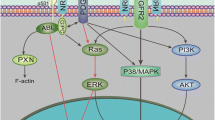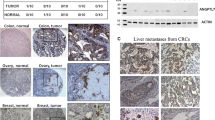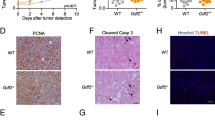Abstract
A series of overexpression studies have shown that lumican suppresses angiogenesis in tumors produced from pancreatic adenocarcinoma, fibrosarcoma, and melanoma tumor cells. Despite lumican’s anti-angiogenic activity, a clear correlation of differential expression of lumican in various cancers and cancer malignancy has failed to emerge. Therefore, we hypothesized that either 1.) endogenously expressed lumican is not anti-angiogenic or alternatively that 2.) lumican exhibits angiostatic activity only in limited microenvironments. Previously, lumican was shown to suppress tumor growth and angiogenesis in subcutaneously injected PanO2 pancreatic adenocarcinoma cells. Therefore, to determine if endogenously expressed lumican is anti-angiogenic we subcutaneously injected PanO2 cells into wild-type and lumican knockout mice and compared tumor growth and vascular densities of the resulting tumors. We found that tumors grown in lumican knockout animals were larger and contained significantly elevated vascular densities compared to those grown in wild-type mice. Interestingly however lumican knockout animals did not exhibit enhanced angiogenesis in aortic ring assays, matrigel plugs, or healing wound biopsies raising the possibility that lumican suppresses angiogenesis only in tumor microenvironments. To test this possibility, we sought a tumor model wherein lumican did not exhibit anti-angiogenic activity. Utilizing the 4T1 breast cancer model, we found that lumican suppressed 4T1 tumor growth and lung metastasis, but not angiogenesis. In conclusion, these results show that the angiostatic activity of lumican is dependent on currently undefined microenvironmental cues and therefore helps to understand why differential expression of lumican does not consistently correlate with human tumor malignancy.







Similar content being viewed by others
References
Aird WC (2012) Endothelial cell heterogeneity. Cold Spring Harb Perspect Med 2:a006429
Albig AR et al (2007) Transcriptome analysis of endothelial cell gene expression induced by growth on matrigel matrices: identification and characterization of MAGP-2 and lumican as novel regulators of angiogenesis. Angiogenesis 10:197–216
Austin BA et al (2002) Altered collagen fibril formation in the sclera of lumican-deficient mice. Invest Ophthalmol Vis Sci 43:1695–1701
Brezillon S et al (2007) Expression of lumican, a small leucine-rich proteoglycan with antitumour activity, in human malignant melanoma. Clin Exp Dermatol 32:405–416
Brezillon S et al (2009) Lumican core protein inhibits melanoma cell migration via alterations of focal adhesion complexes. Cancer Lett 283:92–100
Brezillon S et al (2009) Lumican inhibits B16F1 melanoma cell lung metastasis. J Physiol Pharmacol 60(Suppl 4):15–22
Brown LJ et al (2010) Lipocalin-7 is a Matricellular regulator of angiogenesis. PLoS One 5:e13905
Coulson-Thomas VJ et al (2013) Lumican expression, localization and antitumor activity in prostate cancer. Exp Cell Res 319:967–981
Dhanasekaran SM et al (2001) Delineation of prognostic biomarkers in prostate cancer. Nature 412:822–826
Eshchenko TY et al (2007) Expression of different proteoglycans in human breast tumors. Biochemistry (Mosc) 72:1016–1020
Lapointe J et al (2004) Gene expression profiling identifies clinically relevant subtypes of prostate cancer. Proc Natl Acad Sci U S A 101:811–816
Leygue E et al (1998) Expression of lumican in human breast carcinoma. Cancer Res 58:1348–1352
Li Y et al (2004) Cleavage of lumican by membrane-type matrix metalloproteinase-1 abrogates this proteoglycan-mediated suppression of tumor cell colony formation in soft agar. Cancer Res 64:7058–7064
Lu P et al (2012) The extracellular matrix: a dynamic niche in cancer progression. J Cell Biol 196:395–406
Niewiarowska J et al (2011) Lumican inhibits angiogenesis by interfering with alpha2beta1 receptor activity and downregulating MMP-14 expression. Thromb Res 128:452–457
Proia DA, Kuperwasser C (2005) Stroma: tumor agonist or antagonist. Cell Cycle 4:1022–1025
Rada JA et al (1993) Regulation of corneal collagen fibrillogenesis in vitro by corneal proteoglycan (lumican and decorin) core proteins. Exp Eye Res 56:635–648
Radwanska A et al (2012) Overexpression of lumican affects the migration of human colon cancer cells through up-regulation of gelsolin and filamentous actin reorganization. Exp Cell Res 318:2312–2323
Saika S et al (2000) Role of lumican in the corneal epithelium during wound healing. J Biol Chem 275:2607–2612
Seya T et al (2006) Lumican expression in advanced colorectal cancer with nodal metastasis correlates with poor prognosis. Oncol Rep 16:1225–1230
Sharma B, Albig AR (2013) Matrix Gla protein reinforces angiogenic resolution. Microvasc Res 85:24–33
Troup S et al (2003) Reduced expression of the small leucine-rich proteoglycans, lumican, and decorin is associated with poor outcome in node-negative invasive breast cancer. Clin Cancer Res 9:207–214
Vuillermoz B et al (2004) The small leucine-rich proteoglycan lumican inhibits melanoma progression. Exp Cell Res 296:294–306
Williams KE, Fulford LA, Albig AR (2010) Lumican reduces tumor growth via induction of fas-mediated endothelial cell apoptosis. Cancer Microenviron 4:115–126
Yamamoto T et al (2012) Secreted 70 kDa lumican stimulates growth and inhibits invasion of human pancreatic cancer. Cancer Lett 320:31–39
Yeh JT et al (2010) Impaired skin wound healing in lumican-null mice. Br J Dermatol 163:1174–1180
Zagris N (2001) Extracellular matrix in development of the early embryo. Micron 32:427–438
Acknowledgments
We are thankful to the NIH (Grant # 3R15CA133829-01A1S1 to ARA), and the INBRE program NIH Grant # P20 RR016454 (National Center for Research Resources) and # P20 GM103408 (National Institute of General Medical Sciences) for funding support. Thank you to Dr. Ken Cornell (Boise State University) for critical reading of the manuscript and excellent suggestions.
Author information
Authors and Affiliations
Corresponding author
Rights and permissions
About this article
Cite this article
Sharma, B., Ramus, M.D., Kirkwood, C.T. et al. Lumican Exhibits Anti-Angiogenic Activity in a Context Specific Manner. Cancer Microenvironment 6, 263–271 (2013). https://doi.org/10.1007/s12307-013-0134-2
Received:
Accepted:
Published:
Issue Date:
DOI: https://doi.org/10.1007/s12307-013-0134-2




